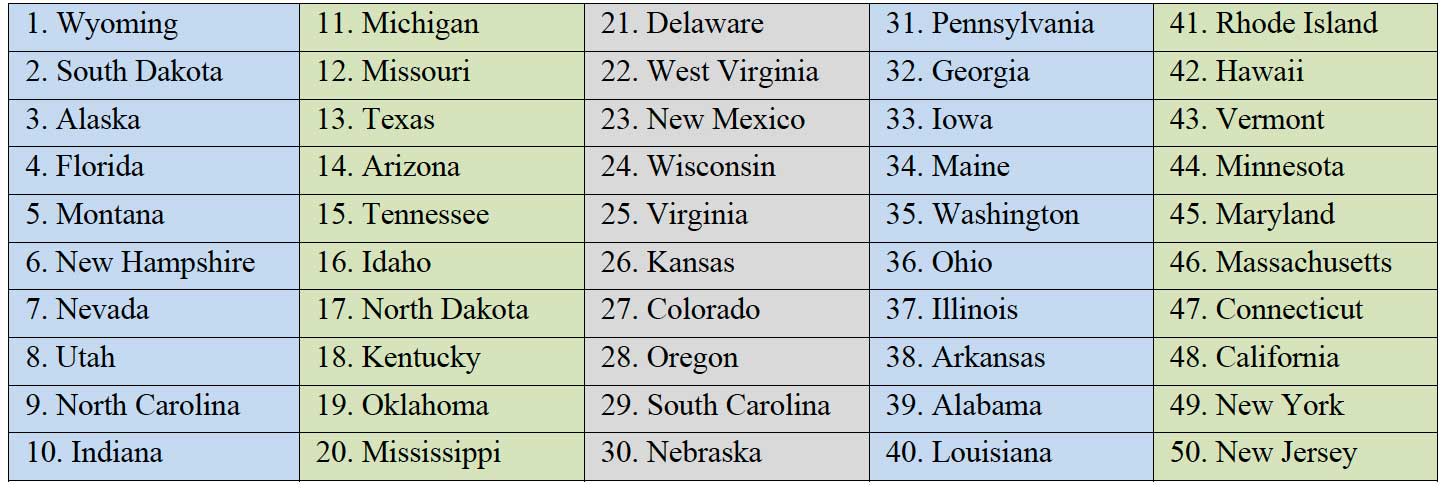As businesses navigate the complexities of the American economic landscape, understanding the intricacies of tax climates can be pivotal. Among the resources available, the State Business Tax Climate Index serves as a compass, aiding entrepreneurs in discerning where to establish, grow, or consolidate their operations. The latest iteration, the 2024 Index, promises significant insights into how state tax policies might either invigorate or inhibit business prosperity.
Firstly, one must consider what the Index encapsulates. The State Business Tax Climate Index is designed to measure how states fare in terms of their tax policies—covering corporate taxes, personal income tax, sales tax, unemployment insurance tax, and property taxes. Each of these components plays a critical role in shaping the business environment. For example, states with high corporate tax rates often see diminished investment levels as companies seek more favorable locales. Conversely, states that maintain a competitive tax structure can attract a plethora of startups and established businesses alike. Thus, an understanding of these rankings becomes essential for any entrepreneur assessing their next steps.
Delving deeper into the findings of the 2024 Index reveals a tapestry of regulatory landscapes. Various states are vying for the title of “most business-friendly,” echoing a narrative of fierce competition that ultimately benefits businesses. Consider states like Florida or Texas, which historically perform well due to their lack of personal income taxes and business-friendly policies. Their favorable tax situations catalyze economic growth and attract diverse industries, from technology to manufacturing. Businesses that factor in these elements can strategize accordingly, wielding the Index as a tool to bolster their operational foothold.
However, it is also crucial to recognize the multifaceted nature of tax policy implications. While a competitive tax climate may be appealing, it is not the sole determinant of business success. Factors such as workforce availability, infrastructure quality, and regional market dynamics must also be considered. For instance, states with lower tax burdens but a less skilled workforce may not provide the same benefits as states with higher taxes but a well-educated populace. Therefore, when businesses analyze the Index, they need to integrate broader economic indicators to attain a holistic view of the opportunities and challenges ahead.
Additionally, the Index underscores the significance of state-level decisions. Each state possesses unique economic aspirations, often reflected in their tax policies. Some states may prioritize attracting large corporations, while others might focus on supporting local startups or fostering innovation ecosystems. For instance, states such as California may impose higher taxes but simultaneously invest heavily in technology and green initiatives. These deliberate choices often result in a thriving economy, where the benefits of higher taxation are offset by abundant resources for businesses to leverage. Thus, understanding the rationale behind state tax structures can provide business leaders with insights into future trends and potential alterations in the competitive landscape.
As we further dissect the Index, it becomes apparent that adaptability is key for businesses. In an era marked by technological advancement and shifting economic realities, the ability to pivot and adjust to new tax conditions is invaluable. For instance, the rise of remote work has prompted various states to reconsider their taxation models, as they seek to capture tax revenue from individuals and businesses no longer tethered to physical locations. Therefore, for a business contemplating expansion into a new state, examining how those evolving tax structures align with their operational model becomes essential.
Moreover, transparency in tax structures often promises greater clarity for businesses. States that provide comprehensive guides, clear regulations, and predictability in their tax regimes tend to cultivate a more favorable operating environment. The 2024 Index highlights states that excel in these areas, emphasizing the importance of clear communication between government entities and business leaders. For companies, effective engagement with tax officials and ongoing education regarding local tax regulations can demystify the landscape and facilitate better decision-making. This transparency not only bolsters business confidence but can also propel industries toward sustainable growth.
Furthermore, businesses must also remain vigilant about potential changes in the political arena that could significantly impact tax policies. The shifting sands of political leadership can lead to fluctuations in tax rates and regulations, underscoring the necessity for businesses to adopt a proactive approach. Keeping an ear to the ground on legislative developments at both state and federal levels can empower companies to prepare for changes that may otherwise catch them off guard. In this regard, analyzing trends and historical shifts in tax legislation can equip businesses with the foresight needed to adapt successfully.
In conclusion, the 2024 State Business Tax Climate Index provides a prism through which businesses can interpret the varying tax environments across the United States. It serves as an essential tool for understanding the myriad factors that influence business success and sustainability. By weaving together insights from the Index with broader economic factors and remaining attuned to the political landscape, businesses can tactically position themselves for growth. Ultimately, as the adage goes, knowledge is power; and in the world of business, wielding the right information can mean the difference between boost and bust.
